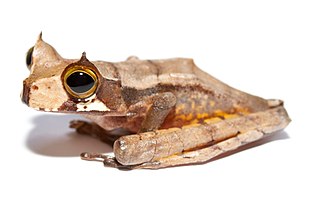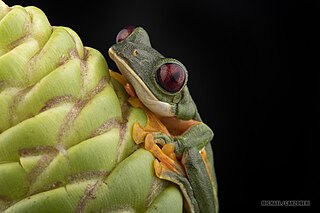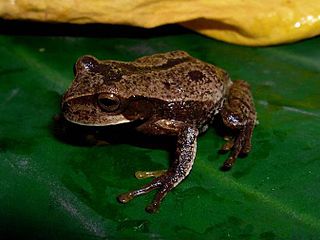
Gastrotheca is a genus of frogs in the family Hemiphractidae. They are found in Central America south of Costa Rica and in South America. Most species occur in the American Cordillera from southern Costa Rica to north-western Argentina. This genus makes up the bulk of marsupial frog diversity; formerly it was placed in the "Leptodactylidae" assemblage.

Nymphargus grandisonae is a species of frog in the family Centrolenidae. It is found in Andes of Colombia and Ecuador. Its natural habitat is tropical moist montane forest ; larvae develop in streams and still-water pools. Its habitat is threatened by habitat loss, introduced fish, and agricultural pollution, but it is still a common species not considered threatened by the IUCN.
Nymphargus balionota is a species of frog in the family Centrolenidae. It is found in the Andes of Colombia and Ecuador. Common names Mindo Cochran frog and mottled glassfrog has been coined for it.

The gliding tree frog is a species of frog in the subfamily Phyllomedusinae. It is found in Colombia, Costa Rica, Ecuador, and Panama. Other common names are the gliding leaf frog, Spurrell's leaf frog, and pink-sided tree frog. The specific name, spurrelli, is in honour of British zoologist Herbert George Flaxman Spurrell.
Niceforonia dolops is a species of frog in the family Strabomantidae. It is found in the Andes of southern Colombia and northern Ecuador. Specifically, it is known from the Cordillera Oriental and Colombian Massif in Caquetá and Putumayo Departments, Colombia, and Napo Province, Ecuador. Common name Putumayo robber frog has been coined for it.
Gastrotheca abdita is a species of frog in the family Hemiphractidae. It is endemic to Peru and only known from the Cordillera Colán in the Amazonas Region. The specific name abdita is Latin for "exiled" or "removed" and refers to the geographic isolation of the Cordillera Colán. Common name Cordillera Colan marsupial frog has been coined for it.

Gastrotheca argenteovirens is a species of frog in the family Hemiphractidae. It is endemic to Colombia and occurs in the Colombian Massif, Cordillera Central, and Cordillera Occidental in the Quindío, Tolima, Valle del Cauca, Cauca, and Nariño Departments. Common name Popayan marsupial frog has been coined for it.

The horned marsupial frog, originally named Nototrema cornutum (Boulenger) after the first describer George Albert Boulenger in 1898), is a species of frog in the family Hemiphractidae. It is an arboreal species found in Colombia, Costa Rica, Ecuador and Panama. Its natural habitats are tropical moist lowland forests and montane cloud forests. It is threatened by habitat loss.

Gastrotheca dunni is a species of frog in the family Hemiphractidae. It is endemic to the northern part of the Cordillera Occidental in northern Antioquia, Colombia. The specific name dunni honors Emmett Reid Dunn, an American herpetologist. Common name Dunn's marsupial frog has been coined for it.

Gastrotheca excubitor is a species of frog in the family Hemiphractidae. It is endemic to southern Peru and occurs in the Amazonian slopes and crests of the Cordillera Oriental in the Cusco Region; records from the Cajamarca Region are likely erroneous. It is likely to include cryptic species. Common name Abra Acanacu marsupial frog has been coined for it.

Gastrotheca guentheri is a species of frog in the family Hemiphractidae. It is found in the Andes of Colombia and Ecuador. Gastrotheca guentheri is the only known frog with true teeth in both of its jaws, as indicated by the name of the genus it originally typified, Amphignathodon, described by George Albert Boulenger in 1882.
The Helena's marsupial frog is a species of frog in the family Hemiphractidae. It is endemic to the Páramo de Tamá on the Venezuelan-Colombian border and occurs in Apure and Táchira states of Venezuela and Norte de Santander Department on the Cordillera Oriental of Colombia. It is named after Helen Gaige, an American herpetologist.
Gastrotheca nicefori is a species of frog in the family Hemiphractidae. It is found in the Andes of Colombia, on the Andean slopes of northern Venezuela, and in the highlands of eastern and central Panama.
Gastrotheca ochoai is a species of frog in the family Hemiphractidae. It is endemic to southern Peru and occurs in the interandean valleys on the eastern face of the Andes. The specific name ochoai honors Oscar Ochoa Mendieta, a biology professor from the National University of Saint Anthony the Abbot in Cuzco who helped the species descriptors during the field work. Common name Chilca marsupial frog has been coined for this species.
Gastrotheca pacchamama is a species of frog in the family Hemiphractidae. It is endemic to Peru and only known from the Ayacucho Region in the Cordillera Oriental.

The Andean marsupial tree frog, also known as the Riobamba marsupial frog or Riobamba pouched frog, is a species of frog in the family Hemiphractidae. It is endemic to Ecuador. The species is confined to the Andes and the inter-Andean valleys, from Imbabura south to Chimborazo. They live in an altitude of 2,200-3,500 meters above sea-level. The Andean marsupial tree frog's habitat varies from the montane forests to the dry rocky hillsides, and from the agave plants to the corn fields. Once a common species, it is threatened by severe habitat loss.
Gastrotheca splendens is a species of frog in the family Hemiphractidae. It is endemic to Bolivia. The only precisely known record is from the eastern slopes of the Andes in the Amboró National Park, in the Santa Cruz Department. Only two specimens are known. Common name Schmidt's marsupial frog has been coined for this species, in reference to Eduard Oscar Schmidt who described the species.
Gastrotheca trachyceps is a species of frog in the family Hemiphractidae. It is endemic to the Cauca Department, Colombia, and is known from its type locality, Cerro Munchique in the Cordillera Occidental, and Vereda Santa Elena (Popayán) in the Cordillera Central. The specific name trachyceps is said to be derived from Greek trachy meaning "rough" and Latin ceps meaning "head", in reference to the rough appearance of the head. The proper word in Latin for head, however, is caput. The common name Cerro Munchique marsupial frog has been coined for it.
The Williamson's marsupial frog is a species of frog in the family Hemiphractidae. It is endemic to north-central coastal Venezuela and only known from its type locality, San Esteban in the state of Carabobo. It is a poorly known species that has not been collected since it was first described, based on a single specimen collected in 1920.

Centrolene savagei is a species of frog in the family Centrolenidae that is endemic to the Andes of western Colombia, specifically the Cordillera Occidental and Cordillera Central. Its common name is Savage's Cochran frog.










